Strategic Decision Making in Oil and Gas Industry - GSM London
VerifiedAdded on 2023/06/01
|11
|2807
|58
Report
AI Summary
This report assesses an investment opportunity for China National Petroleum Corporation (CNPC) in Mozambique's gas production, utilizing Porter's Five Forces model and SWOT analysis. It examines competitive rivalry, the threat of new entrants and substitutes, and the bargaining power of buyers and suppliers. The report highlights CNPC's strengths and weaknesses, opportunities in the growing energy demand, and threats from competition and government policies. It concludes with a discussion on decision-making processes for managing risks and ensuring sustainable growth in the oil and gas industry. Desklib offers a wide range of solved assignments and past papers for students.
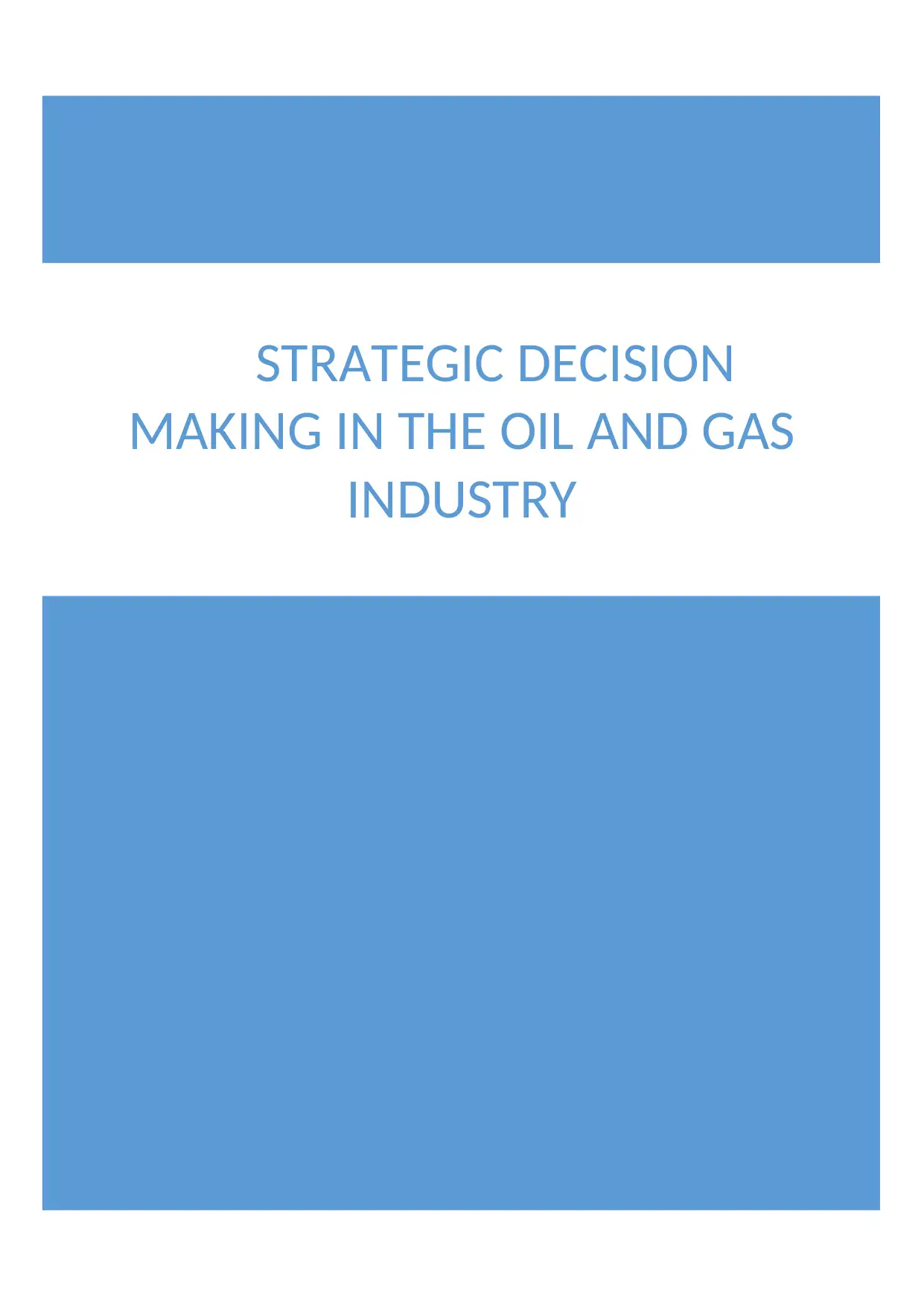
STRATEGIC DECISION
MAKING IN THE OIL AND GAS
INDUSTRY
MAKING IN THE OIL AND GAS
INDUSTRY
Paraphrase This Document
Need a fresh take? Get an instant paraphrase of this document with our AI Paraphraser

REPORT: 1
Contents
Introduction...........................................................................................................................................2
Porter`s five forces model......................................................................................................................2
SWOT analysis......................................................................................................................................5
Decision-making...................................................................................................................................7
Conclusion.............................................................................................................................................7
References.............................................................................................................................................9
Contents
Introduction...........................................................................................................................................2
Porter`s five forces model......................................................................................................................2
SWOT analysis......................................................................................................................................5
Decision-making...................................................................................................................................7
Conclusion.............................................................................................................................................7
References.............................................................................................................................................9
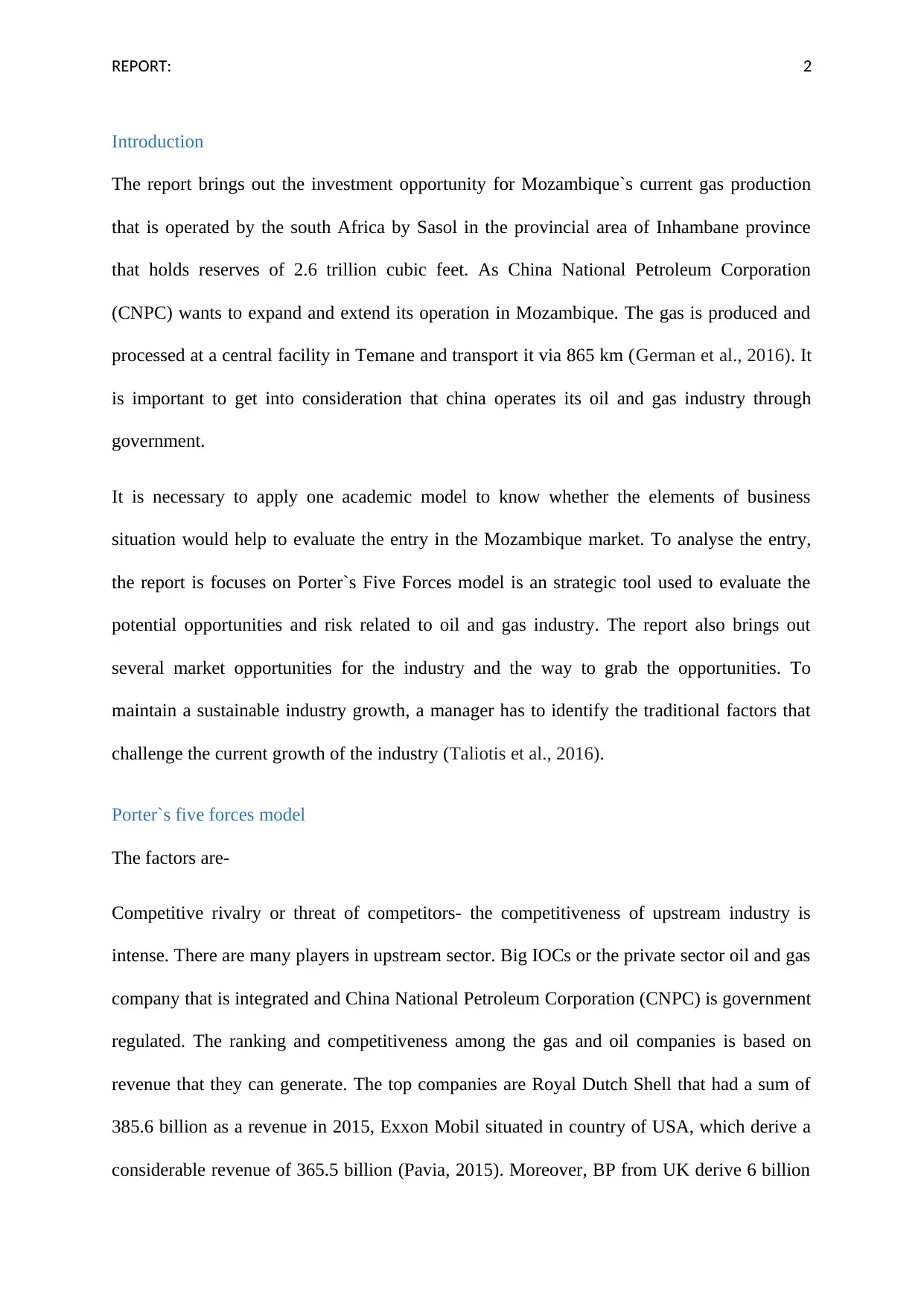
REPORT: 2
Introduction
The report brings out the investment opportunity for Mozambique`s current gas production
that is operated by the south Africa by Sasol in the provincial area of Inhambane province
that holds reserves of 2.6 trillion cubic feet. As China National Petroleum Corporation
(CNPC) wants to expand and extend its operation in Mozambique. The gas is produced and
processed at a central facility in Temane and transport it via 865 km (German et al., 2016). It
is important to get into consideration that china operates its oil and gas industry through
government.
It is necessary to apply one academic model to know whether the elements of business
situation would help to evaluate the entry in the Mozambique market. To analyse the entry,
the report is focuses on Porter`s Five Forces model is an strategic tool used to evaluate the
potential opportunities and risk related to oil and gas industry. The report also brings out
several market opportunities for the industry and the way to grab the opportunities. To
maintain a sustainable industry growth, a manager has to identify the traditional factors that
challenge the current growth of the industry (Taliotis et al., 2016).
Porter`s five forces model
The factors are-
Competitive rivalry or threat of competitors- the competitiveness of upstream industry is
intense. There are many players in upstream sector. Big IOCs or the private sector oil and gas
company that is integrated and China National Petroleum Corporation (CNPC) is government
regulated. The ranking and competitiveness among the gas and oil companies is based on
revenue that they can generate. The top companies are Royal Dutch Shell that had a sum of
385.6 billion as a revenue in 2015, Exxon Mobil situated in country of USA, which derive a
considerable revenue of 365.5 billion (Pavia, 2015). Moreover, BP from UK derive 6 billion
Introduction
The report brings out the investment opportunity for Mozambique`s current gas production
that is operated by the south Africa by Sasol in the provincial area of Inhambane province
that holds reserves of 2.6 trillion cubic feet. As China National Petroleum Corporation
(CNPC) wants to expand and extend its operation in Mozambique. The gas is produced and
processed at a central facility in Temane and transport it via 865 km (German et al., 2016). It
is important to get into consideration that china operates its oil and gas industry through
government.
It is necessary to apply one academic model to know whether the elements of business
situation would help to evaluate the entry in the Mozambique market. To analyse the entry,
the report is focuses on Porter`s Five Forces model is an strategic tool used to evaluate the
potential opportunities and risk related to oil and gas industry. The report also brings out
several market opportunities for the industry and the way to grab the opportunities. To
maintain a sustainable industry growth, a manager has to identify the traditional factors that
challenge the current growth of the industry (Taliotis et al., 2016).
Porter`s five forces model
The factors are-
Competitive rivalry or threat of competitors- the competitiveness of upstream industry is
intense. There are many players in upstream sector. Big IOCs or the private sector oil and gas
company that is integrated and China National Petroleum Corporation (CNPC) is government
regulated. The ranking and competitiveness among the gas and oil companies is based on
revenue that they can generate. The top companies are Royal Dutch Shell that had a sum of
385.6 billion as a revenue in 2015, Exxon Mobil situated in country of USA, which derive a
considerable revenue of 365.5 billion (Pavia, 2015). Moreover, BP from UK derive 6 billion
⊘ This is a preview!⊘
Do you want full access?
Subscribe today to unlock all pages.

Trusted by 1+ million students worldwide

REPORT: 3
dollars of revenue in 2015 and total revenue obtained from France announce a big sum of
money approximately 194.2 billion dollars. Even after serving the whole country china, it is
not among top competitors. Apart from these competitors, Chevron and Phillips from USA
generate a revenue of 169.2 billion dollars. The previous information relates to revenue in the
year 2015. The best indicator to become a known is to observe the size of the company to the
market capitalisation. Mozambique`s current gas production also faces a competitive rivalry
from several national and international oil companies (News, 2014). The opportunities of
China National Petroleum Corporation (CNPC) to grow in Mozambique. In regards to
exploration, the company continue to prioritise the strategies for resources and improve the
oil and gas production and achieve economically recoverable reserves. The company
announced in 2015 that it expects the output of crude oil to be 924.7 million barrels and gas
production to be around 3,172 billion cubic feet (Petrochina Company Limited, 2015).
Threat of new entrants- This factor has a huge influence on new companies that who enter
into oil and gas business. The establishment in the industry requires a huge capital. Moreover,
National oil and gas companies control 90 percent of the public companies because they are
proven reserves. The industry also has an increased internal competition. If any new company
is established, it requires R &D spending that will give a enhancement in innovation and
progress the existing technology. The new strategy can give a company a competitive
advantage over the new and oil companies. The big IOCs can convince the new competitors
to focus more on spending more capital. The prices of gas industry remains highly volatile.
These reserves are usually situated in war zones and the geographical area with several
geographical conflicts and political uncertainty (Hulshof, Maat, and Mulder, 2016).
Threat from the substitutes in the industry- there are not many alternatives available that can
be used in place of producing energy that assists electricity, heating, and transportation. The
alternatives are nuclear energy, coal, hydrogen, and biofuels and several other renewable
dollars of revenue in 2015 and total revenue obtained from France announce a big sum of
money approximately 194.2 billion dollars. Even after serving the whole country china, it is
not among top competitors. Apart from these competitors, Chevron and Phillips from USA
generate a revenue of 169.2 billion dollars. The previous information relates to revenue in the
year 2015. The best indicator to become a known is to observe the size of the company to the
market capitalisation. Mozambique`s current gas production also faces a competitive rivalry
from several national and international oil companies (News, 2014). The opportunities of
China National Petroleum Corporation (CNPC) to grow in Mozambique. In regards to
exploration, the company continue to prioritise the strategies for resources and improve the
oil and gas production and achieve economically recoverable reserves. The company
announced in 2015 that it expects the output of crude oil to be 924.7 million barrels and gas
production to be around 3,172 billion cubic feet (Petrochina Company Limited, 2015).
Threat of new entrants- This factor has a huge influence on new companies that who enter
into oil and gas business. The establishment in the industry requires a huge capital. Moreover,
National oil and gas companies control 90 percent of the public companies because they are
proven reserves. The industry also has an increased internal competition. If any new company
is established, it requires R &D spending that will give a enhancement in innovation and
progress the existing technology. The new strategy can give a company a competitive
advantage over the new and oil companies. The big IOCs can convince the new competitors
to focus more on spending more capital. The prices of gas industry remains highly volatile.
These reserves are usually situated in war zones and the geographical area with several
geographical conflicts and political uncertainty (Hulshof, Maat, and Mulder, 2016).
Threat from the substitutes in the industry- there are not many alternatives available that can
be used in place of producing energy that assists electricity, heating, and transportation. The
alternatives are nuclear energy, coal, hydrogen, and biofuels and several other renewable
Paraphrase This Document
Need a fresh take? Get an instant paraphrase of this document with our AI Paraphraser
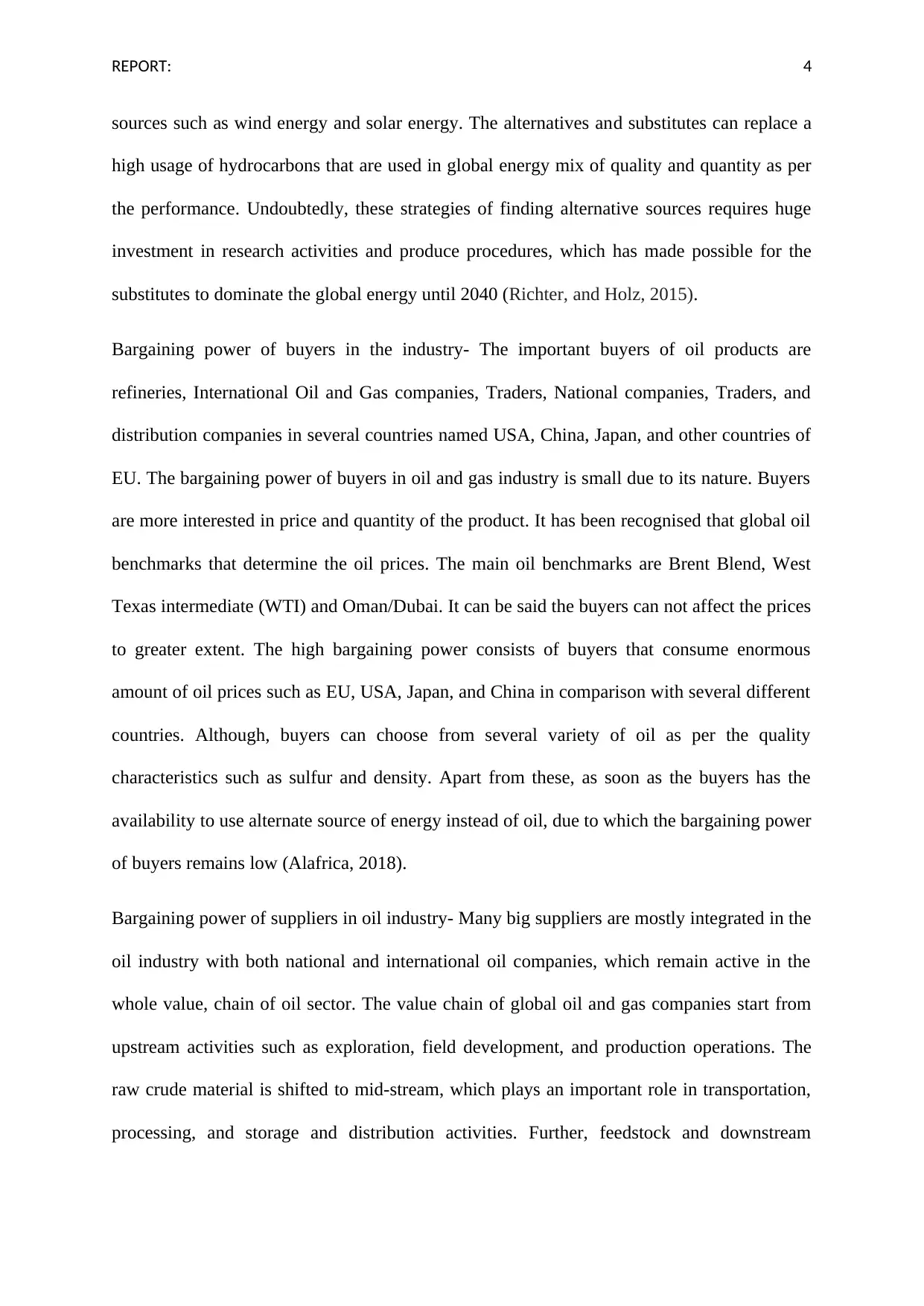
REPORT: 4
sources such as wind energy and solar energy. The alternatives and substitutes can replace a
high usage of hydrocarbons that are used in global energy mix of quality and quantity as per
the performance. Undoubtedly, these strategies of finding alternative sources requires huge
investment in research activities and produce procedures, which has made possible for the
substitutes to dominate the global energy until 2040 (Richter, and Holz, 2015).
Bargaining power of buyers in the industry- The important buyers of oil products are
refineries, International Oil and Gas companies, Traders, National companies, Traders, and
distribution companies in several countries named USA, China, Japan, and other countries of
EU. The bargaining power of buyers in oil and gas industry is small due to its nature. Buyers
are more interested in price and quantity of the product. It has been recognised that global oil
benchmarks that determine the oil prices. The main oil benchmarks are Brent Blend, West
Texas intermediate (WTI) and Oman/Dubai. It can be said the buyers can not affect the prices
to greater extent. The high bargaining power consists of buyers that consume enormous
amount of oil prices such as EU, USA, Japan, and China in comparison with several different
countries. Although, buyers can choose from several variety of oil as per the quality
characteristics such as sulfur and density. Apart from these, as soon as the buyers has the
availability to use alternate source of energy instead of oil, due to which the bargaining power
of buyers remains low (Alafrica, 2018).
Bargaining power of suppliers in oil industry- Many big suppliers are mostly integrated in the
oil industry with both national and international oil companies, which remain active in the
whole value, chain of oil sector. The value chain of global oil and gas companies start from
upstream activities such as exploration, field development, and production operations. The
raw crude material is shifted to mid-stream, which plays an important role in transportation,
processing, and storage and distribution activities. Further, feedstock and downstream
sources such as wind energy and solar energy. The alternatives and substitutes can replace a
high usage of hydrocarbons that are used in global energy mix of quality and quantity as per
the performance. Undoubtedly, these strategies of finding alternative sources requires huge
investment in research activities and produce procedures, which has made possible for the
substitutes to dominate the global energy until 2040 (Richter, and Holz, 2015).
Bargaining power of buyers in the industry- The important buyers of oil products are
refineries, International Oil and Gas companies, Traders, National companies, Traders, and
distribution companies in several countries named USA, China, Japan, and other countries of
EU. The bargaining power of buyers in oil and gas industry is small due to its nature. Buyers
are more interested in price and quantity of the product. It has been recognised that global oil
benchmarks that determine the oil prices. The main oil benchmarks are Brent Blend, West
Texas intermediate (WTI) and Oman/Dubai. It can be said the buyers can not affect the prices
to greater extent. The high bargaining power consists of buyers that consume enormous
amount of oil prices such as EU, USA, Japan, and China in comparison with several different
countries. Although, buyers can choose from several variety of oil as per the quality
characteristics such as sulfur and density. Apart from these, as soon as the buyers has the
availability to use alternate source of energy instead of oil, due to which the bargaining power
of buyers remains low (Alafrica, 2018).
Bargaining power of suppliers in oil industry- Many big suppliers are mostly integrated in the
oil industry with both national and international oil companies, which remain active in the
whole value, chain of oil sector. The value chain of global oil and gas companies start from
upstream activities such as exploration, field development, and production operations. The
raw crude material is shifted to mid-stream, which plays an important role in transportation,
processing, and storage and distribution activities. Further, feedstock and downstream
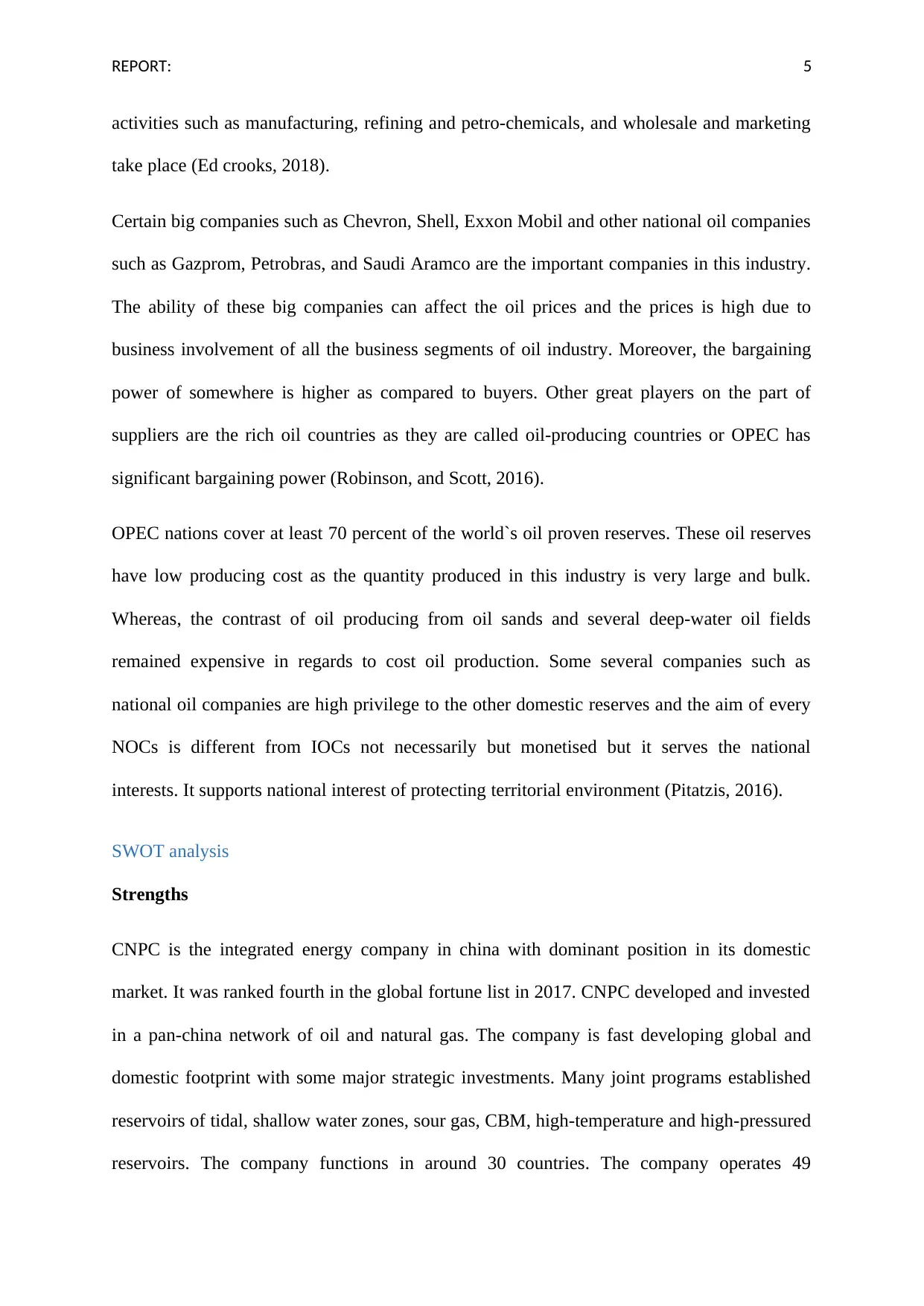
REPORT: 5
activities such as manufacturing, refining and petro-chemicals, and wholesale and marketing
take place (Ed crooks, 2018).
Certain big companies such as Chevron, Shell, Exxon Mobil and other national oil companies
such as Gazprom, Petrobras, and Saudi Aramco are the important companies in this industry.
The ability of these big companies can affect the oil prices and the prices is high due to
business involvement of all the business segments of oil industry. Moreover, the bargaining
power of somewhere is higher as compared to buyers. Other great players on the part of
suppliers are the rich oil countries as they are called oil-producing countries or OPEC has
significant bargaining power (Robinson, and Scott, 2016).
OPEC nations cover at least 70 percent of the world`s oil proven reserves. These oil reserves
have low producing cost as the quantity produced in this industry is very large and bulk.
Whereas, the contrast of oil producing from oil sands and several deep-water oil fields
remained expensive in regards to cost oil production. Some several companies such as
national oil companies are high privilege to the other domestic reserves and the aim of every
NOCs is different from IOCs not necessarily but monetised but it serves the national
interests. It supports national interest of protecting territorial environment (Pitatzis, 2016).
SWOT analysis
Strengths
CNPC is the integrated energy company in china with dominant position in its domestic
market. It was ranked fourth in the global fortune list in 2017. CNPC developed and invested
in a pan-china network of oil and natural gas. The company is fast developing global and
domestic footprint with some major strategic investments. Many joint programs established
reservoirs of tidal, shallow water zones, sour gas, CBM, high-temperature and high-pressured
reservoirs. The company functions in around 30 countries. The company operates 49
activities such as manufacturing, refining and petro-chemicals, and wholesale and marketing
take place (Ed crooks, 2018).
Certain big companies such as Chevron, Shell, Exxon Mobil and other national oil companies
such as Gazprom, Petrobras, and Saudi Aramco are the important companies in this industry.
The ability of these big companies can affect the oil prices and the prices is high due to
business involvement of all the business segments of oil industry. Moreover, the bargaining
power of somewhere is higher as compared to buyers. Other great players on the part of
suppliers are the rich oil countries as they are called oil-producing countries or OPEC has
significant bargaining power (Robinson, and Scott, 2016).
OPEC nations cover at least 70 percent of the world`s oil proven reserves. These oil reserves
have low producing cost as the quantity produced in this industry is very large and bulk.
Whereas, the contrast of oil producing from oil sands and several deep-water oil fields
remained expensive in regards to cost oil production. Some several companies such as
national oil companies are high privilege to the other domestic reserves and the aim of every
NOCs is different from IOCs not necessarily but monetised but it serves the national
interests. It supports national interest of protecting territorial environment (Pitatzis, 2016).
SWOT analysis
Strengths
CNPC is the integrated energy company in china with dominant position in its domestic
market. It was ranked fourth in the global fortune list in 2017. CNPC developed and invested
in a pan-china network of oil and natural gas. The company is fast developing global and
domestic footprint with some major strategic investments. Many joint programs established
reservoirs of tidal, shallow water zones, sour gas, CBM, high-temperature and high-pressured
reservoirs. The company functions in around 30 countries. The company operates 49
⊘ This is a preview!⊘
Do you want full access?
Subscribe today to unlock all pages.

Trusted by 1+ million students worldwide
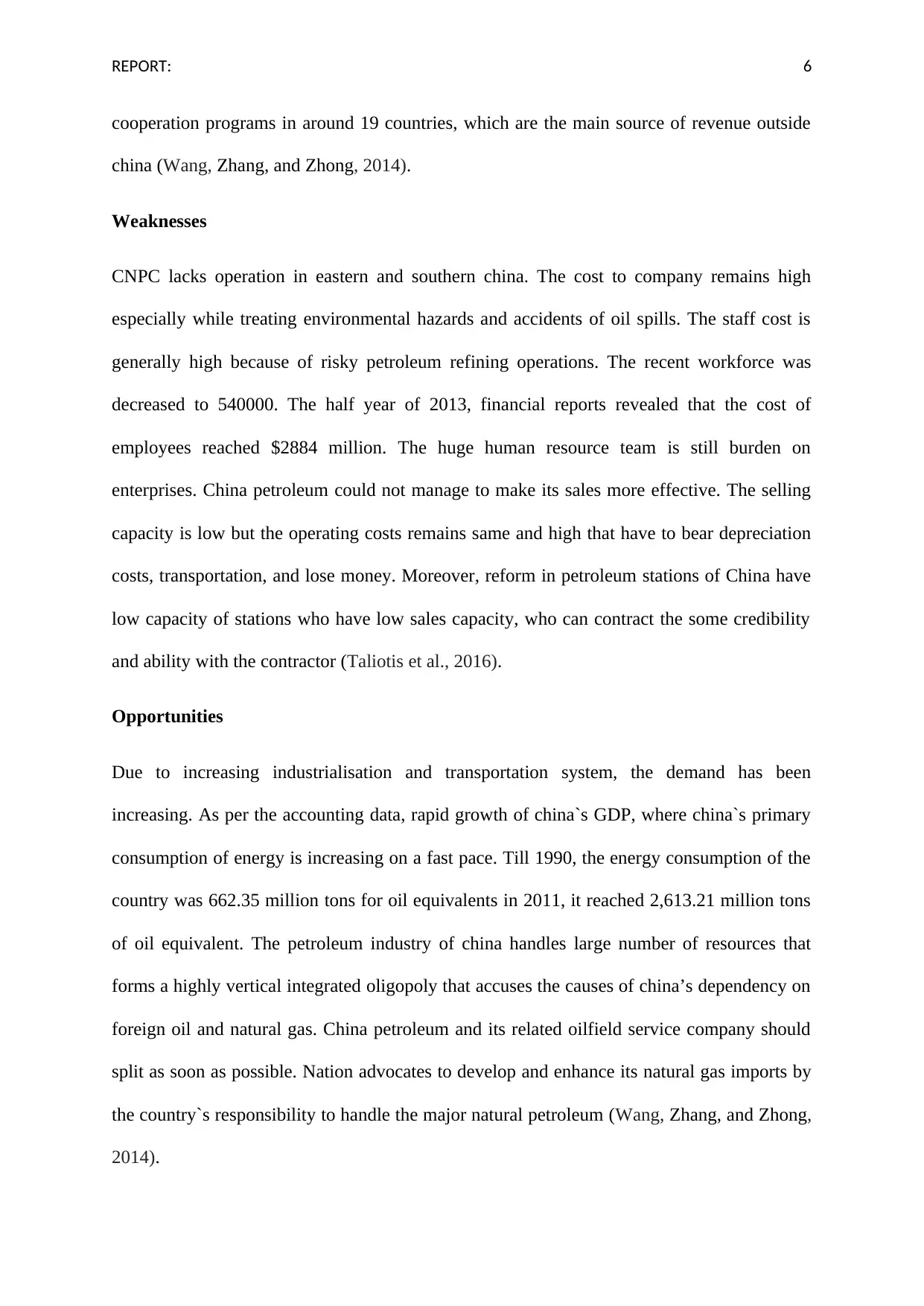
REPORT: 6
cooperation programs in around 19 countries, which are the main source of revenue outside
china (Wang, Zhang, and Zhong, 2014).
Weaknesses
CNPC lacks operation in eastern and southern china. The cost to company remains high
especially while treating environmental hazards and accidents of oil spills. The staff cost is
generally high because of risky petroleum refining operations. The recent workforce was
decreased to 540000. The half year of 2013, financial reports revealed that the cost of
employees reached $2884 million. The huge human resource team is still burden on
enterprises. China petroleum could not manage to make its sales more effective. The selling
capacity is low but the operating costs remains same and high that have to bear depreciation
costs, transportation, and lose money. Moreover, reform in petroleum stations of China have
low capacity of stations who have low sales capacity, who can contract the some credibility
and ability with the contractor (Taliotis et al., 2016).
Opportunities
Due to increasing industrialisation and transportation system, the demand has been
increasing. As per the accounting data, rapid growth of china`s GDP, where china`s primary
consumption of energy is increasing on a fast pace. Till 1990, the energy consumption of the
country was 662.35 million tons for oil equivalents in 2011, it reached 2,613.21 million tons
of oil equivalent. The petroleum industry of china handles large number of resources that
forms a highly vertical integrated oligopoly that accuses the causes of china’s dependency on
foreign oil and natural gas. China petroleum and its related oilfield service company should
split as soon as possible. Nation advocates to develop and enhance its natural gas imports by
the country`s responsibility to handle the major natural petroleum (Wang, Zhang, and Zhong,
2014).
cooperation programs in around 19 countries, which are the main source of revenue outside
china (Wang, Zhang, and Zhong, 2014).
Weaknesses
CNPC lacks operation in eastern and southern china. The cost to company remains high
especially while treating environmental hazards and accidents of oil spills. The staff cost is
generally high because of risky petroleum refining operations. The recent workforce was
decreased to 540000. The half year of 2013, financial reports revealed that the cost of
employees reached $2884 million. The huge human resource team is still burden on
enterprises. China petroleum could not manage to make its sales more effective. The selling
capacity is low but the operating costs remains same and high that have to bear depreciation
costs, transportation, and lose money. Moreover, reform in petroleum stations of China have
low capacity of stations who have low sales capacity, who can contract the some credibility
and ability with the contractor (Taliotis et al., 2016).
Opportunities
Due to increasing industrialisation and transportation system, the demand has been
increasing. As per the accounting data, rapid growth of china`s GDP, where china`s primary
consumption of energy is increasing on a fast pace. Till 1990, the energy consumption of the
country was 662.35 million tons for oil equivalents in 2011, it reached 2,613.21 million tons
of oil equivalent. The petroleum industry of china handles large number of resources that
forms a highly vertical integrated oligopoly that accuses the causes of china’s dependency on
foreign oil and natural gas. China petroleum and its related oilfield service company should
split as soon as possible. Nation advocates to develop and enhance its natural gas imports by
the country`s responsibility to handle the major natural petroleum (Wang, Zhang, and Zhong,
2014).
Paraphrase This Document
Need a fresh take? Get an instant paraphrase of this document with our AI Paraphraser
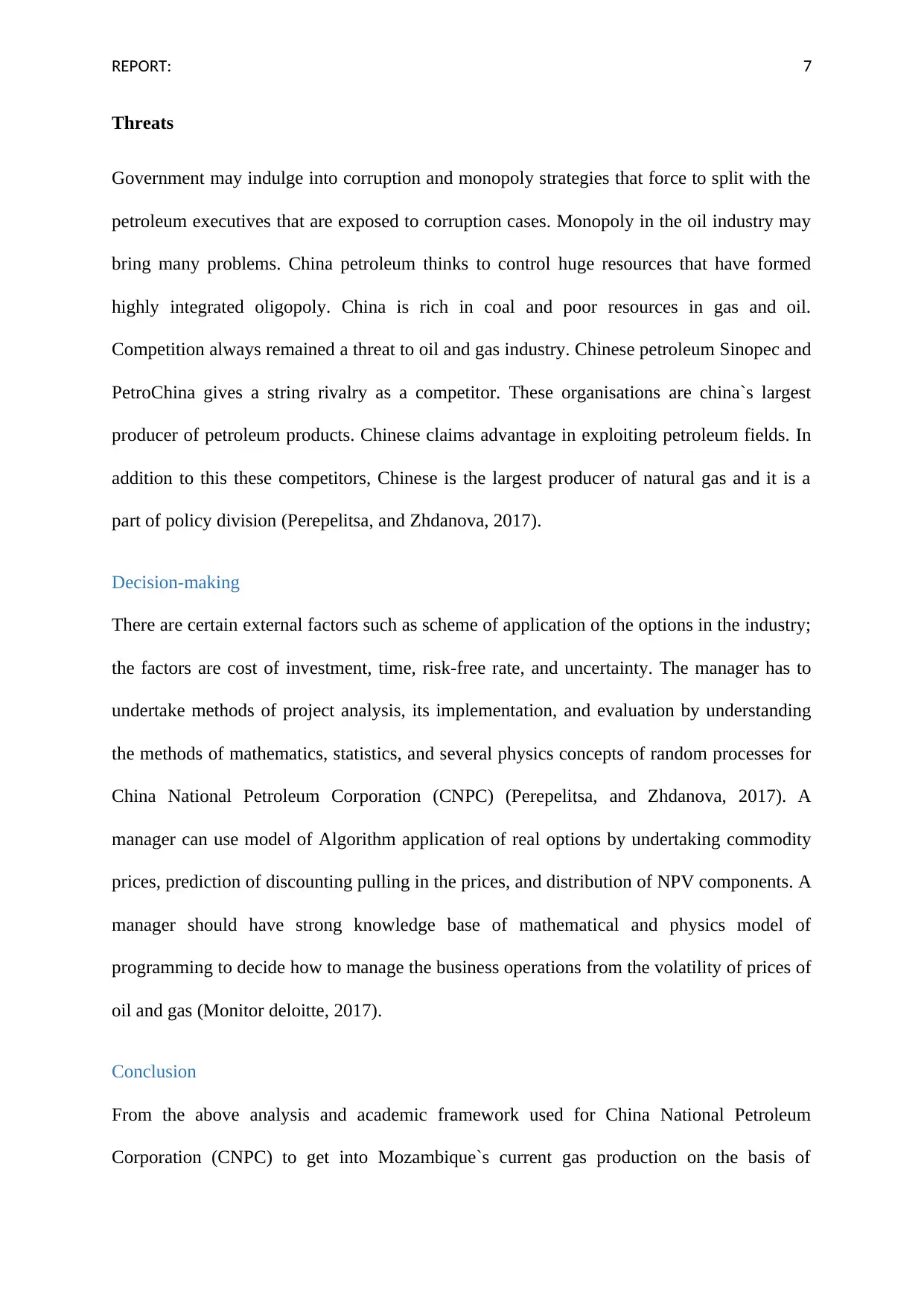
REPORT: 7
Threats
Government may indulge into corruption and monopoly strategies that force to split with the
petroleum executives that are exposed to corruption cases. Monopoly in the oil industry may
bring many problems. China petroleum thinks to control huge resources that have formed
highly integrated oligopoly. China is rich in coal and poor resources in gas and oil.
Competition always remained a threat to oil and gas industry. Chinese petroleum Sinopec and
PetroChina gives a string rivalry as a competitor. These organisations are china`s largest
producer of petroleum products. Chinese claims advantage in exploiting petroleum fields. In
addition to this these competitors, Chinese is the largest producer of natural gas and it is a
part of policy division (Perepelitsa, and Zhdanova, 2017).
Decision-making
There are certain external factors such as scheme of application of the options in the industry;
the factors are cost of investment, time, risk-free rate, and uncertainty. The manager has to
undertake methods of project analysis, its implementation, and evaluation by understanding
the methods of mathematics, statistics, and several physics concepts of random processes for
China National Petroleum Corporation (CNPC) (Perepelitsa, and Zhdanova, 2017). A
manager can use model of Algorithm application of real options by undertaking commodity
prices, prediction of discounting pulling in the prices, and distribution of NPV components. A
manager should have strong knowledge base of mathematical and physics model of
programming to decide how to manage the business operations from the volatility of prices of
oil and gas (Monitor deloitte, 2017).
Conclusion
From the above analysis and academic framework used for China National Petroleum
Corporation (CNPC) to get into Mozambique`s current gas production on the basis of
Threats
Government may indulge into corruption and monopoly strategies that force to split with the
petroleum executives that are exposed to corruption cases. Monopoly in the oil industry may
bring many problems. China petroleum thinks to control huge resources that have formed
highly integrated oligopoly. China is rich in coal and poor resources in gas and oil.
Competition always remained a threat to oil and gas industry. Chinese petroleum Sinopec and
PetroChina gives a string rivalry as a competitor. These organisations are china`s largest
producer of petroleum products. Chinese claims advantage in exploiting petroleum fields. In
addition to this these competitors, Chinese is the largest producer of natural gas and it is a
part of policy division (Perepelitsa, and Zhdanova, 2017).
Decision-making
There are certain external factors such as scheme of application of the options in the industry;
the factors are cost of investment, time, risk-free rate, and uncertainty. The manager has to
undertake methods of project analysis, its implementation, and evaluation by understanding
the methods of mathematics, statistics, and several physics concepts of random processes for
China National Petroleum Corporation (CNPC) (Perepelitsa, and Zhdanova, 2017). A
manager can use model of Algorithm application of real options by undertaking commodity
prices, prediction of discounting pulling in the prices, and distribution of NPV components. A
manager should have strong knowledge base of mathematical and physics model of
programming to decide how to manage the business operations from the volatility of prices of
oil and gas (Monitor deloitte, 2017).
Conclusion
From the above analysis and academic framework used for China National Petroleum
Corporation (CNPC) to get into Mozambique`s current gas production on the basis of
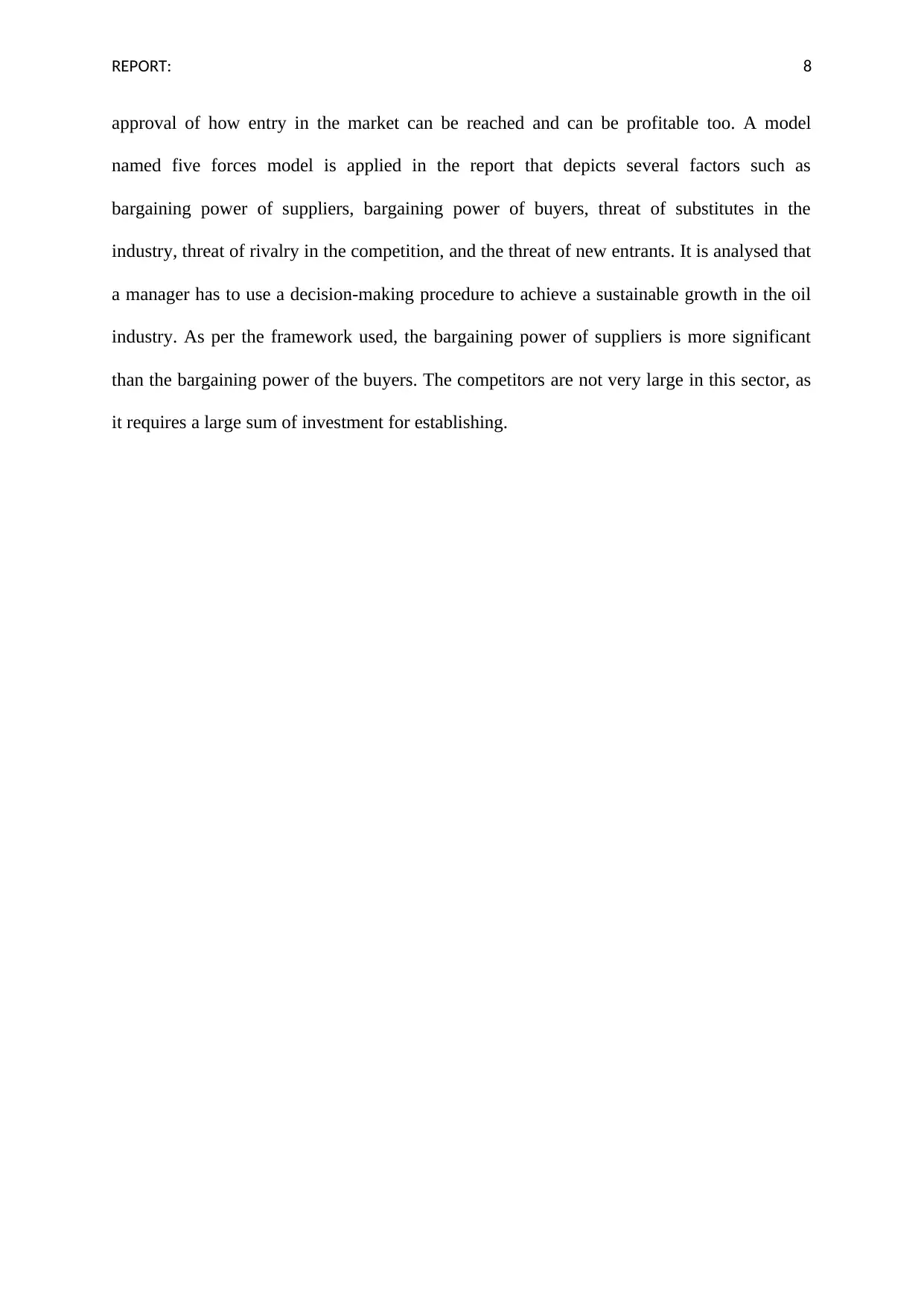
REPORT: 8
approval of how entry in the market can be reached and can be profitable too. A model
named five forces model is applied in the report that depicts several factors such as
bargaining power of suppliers, bargaining power of buyers, threat of substitutes in the
industry, threat of rivalry in the competition, and the threat of new entrants. It is analysed that
a manager has to use a decision-making procedure to achieve a sustainable growth in the oil
industry. As per the framework used, the bargaining power of suppliers is more significant
than the bargaining power of the buyers. The competitors are not very large in this sector, as
it requires a large sum of investment for establishing.
approval of how entry in the market can be reached and can be profitable too. A model
named five forces model is applied in the report that depicts several factors such as
bargaining power of suppliers, bargaining power of buyers, threat of substitutes in the
industry, threat of rivalry in the competition, and the threat of new entrants. It is analysed that
a manager has to use a decision-making procedure to achieve a sustainable growth in the oil
industry. As per the framework used, the bargaining power of suppliers is more significant
than the bargaining power of the buyers. The competitors are not very large in this sector, as
it requires a large sum of investment for establishing.
⊘ This is a preview!⊘
Do you want full access?
Subscribe today to unlock all pages.

Trusted by 1+ million students worldwide

REPORT: 9
References
Alafrica, (2018) Mozambique: Oil and Gas Company Anadarko Receives Government Go-
Ahead. Available on: https://allafrica.com/stories/201803070388.html [Accessed on
08/11/18]
Ed crooks, (2018) Mozambique to become a gas supplier to world: Anadarko-led LNG
project set for investment approval in 2019. Available on:
https://www.ft.com/content/d34685b2-7995-11e8-bc55-50daf11b720d [Accessed on
08/11/18]
German, L., Cavane, E., Sitoe, A. and Braga, C., (2016) Private investment as an engine of
rural development: A confrontation of theory and practice for the case of Mozambique. Land
Use Policy, 52, pp.1-14.
Hulshof, D., van der Maat, J.P. and Mulder, M., (2016) Market fundamentals, competition
and natural-gas prices. Energy Policy, 94, pp.480-491.
Monitor deloitte, (2017) Investment Opportunities in Mozambique Manufacturing Edition,
2017. Available on: https://www2.deloitte.com/content/dam/Deloitte/za/Documents/africa/
za_Monitor_Deloitte_FSD_Manufacturing_Publication_ENG_v2.pdf [Accessed on 08/11/18]
News, (2014) Investments in gas exploration in Mozambique may reach US$100 billion.
Available on: http://www.ecokaya.com/noticia.php?id_not=21 [Accessed on 08/11/18]
Pavia, J.F.L.Z., (2015) 15. THE MARITIME SECURITY IN THE GULF OF GUINEA:
THE ENERGY SECURITY OF EUROPE AND THE POTENTIAL ROLE OF
PORTUGAL. New Challenges of The Atlantic, p.157.
References
Alafrica, (2018) Mozambique: Oil and Gas Company Anadarko Receives Government Go-
Ahead. Available on: https://allafrica.com/stories/201803070388.html [Accessed on
08/11/18]
Ed crooks, (2018) Mozambique to become a gas supplier to world: Anadarko-led LNG
project set for investment approval in 2019. Available on:
https://www.ft.com/content/d34685b2-7995-11e8-bc55-50daf11b720d [Accessed on
08/11/18]
German, L., Cavane, E., Sitoe, A. and Braga, C., (2016) Private investment as an engine of
rural development: A confrontation of theory and practice for the case of Mozambique. Land
Use Policy, 52, pp.1-14.
Hulshof, D., van der Maat, J.P. and Mulder, M., (2016) Market fundamentals, competition
and natural-gas prices. Energy Policy, 94, pp.480-491.
Monitor deloitte, (2017) Investment Opportunities in Mozambique Manufacturing Edition,
2017. Available on: https://www2.deloitte.com/content/dam/Deloitte/za/Documents/africa/
za_Monitor_Deloitte_FSD_Manufacturing_Publication_ENG_v2.pdf [Accessed on 08/11/18]
News, (2014) Investments in gas exploration in Mozambique may reach US$100 billion.
Available on: http://www.ecokaya.com/noticia.php?id_not=21 [Accessed on 08/11/18]
Pavia, J.F.L.Z., (2015) 15. THE MARITIME SECURITY IN THE GULF OF GUINEA:
THE ENERGY SECURITY OF EUROPE AND THE POTENTIAL ROLE OF
PORTUGAL. New Challenges of The Atlantic, p.157.
Paraphrase This Document
Need a fresh take? Get an instant paraphrase of this document with our AI Paraphraser
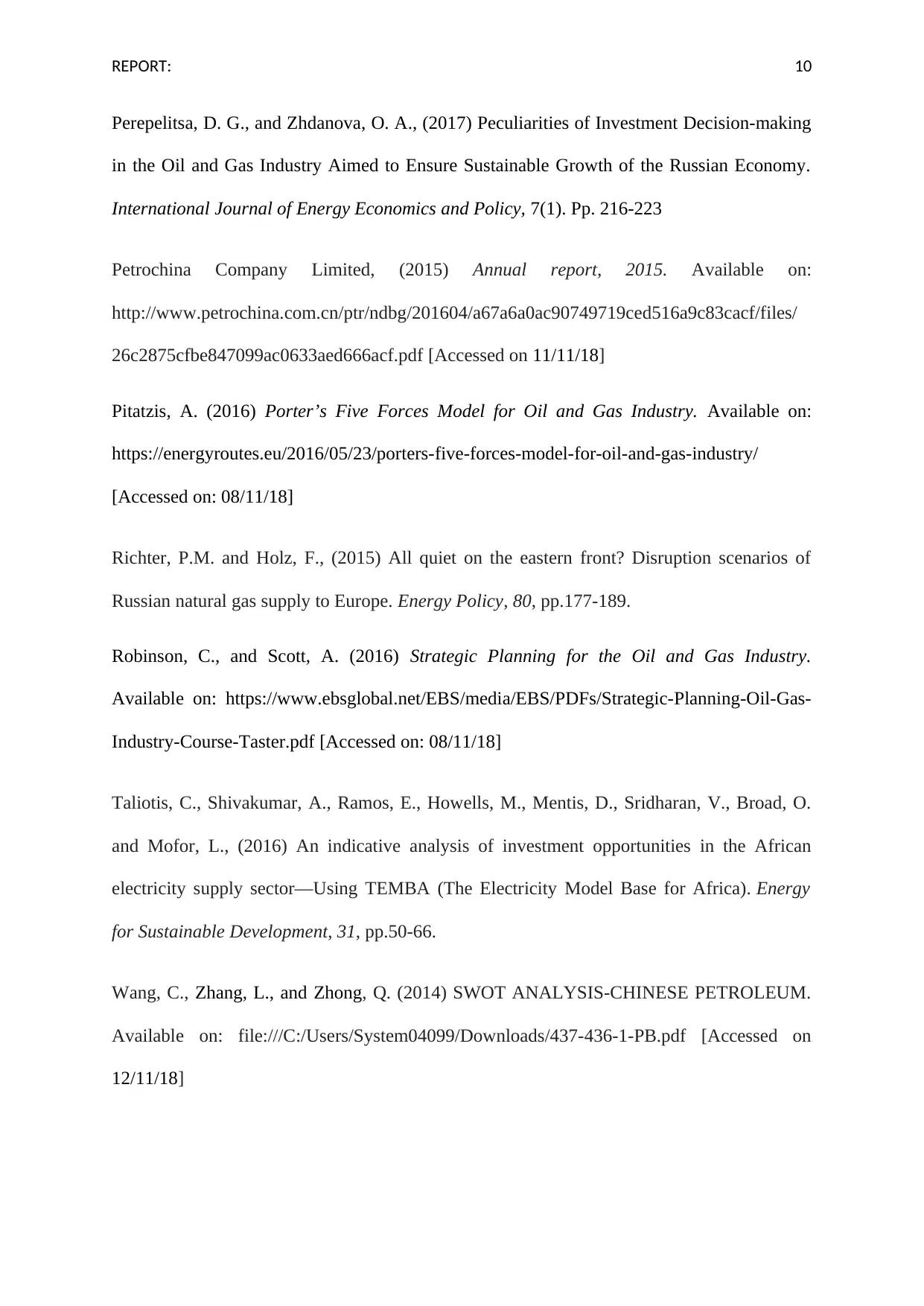
REPORT: 10
Perepelitsa, D. G., and Zhdanova, O. A., (2017) Peculiarities of Investment Decision-making
in the Oil and Gas Industry Aimed to Ensure Sustainable Growth of the Russian Economy.
International Journal of Energy Economics and Policy, 7(1). Pp. 216-223
Petrochina Company Limited, (2015) Annual report, 2015. Available on:
http://www.petrochina.com.cn/ptr/ndbg/201604/a67a6a0ac90749719ced516a9c83cacf/files/
26c2875cfbe847099ac0633aed666acf.pdf [Accessed on 11/11/18]
Pitatzis, A. (2016) Porter’s Five Forces Model for Oil and Gas Industry. Available on:
https://energyroutes.eu/2016/05/23/porters-five-forces-model-for-oil-and-gas-industry/
[Accessed on: 08/11/18]
Richter, P.M. and Holz, F., (2015) All quiet on the eastern front? Disruption scenarios of
Russian natural gas supply to Europe. Energy Policy, 80, pp.177-189.
Robinson, C., and Scott, A. (2016) Strategic Planning for the Oil and Gas Industry.
Available on: https://www.ebsglobal.net/EBS/media/EBS/PDFs/Strategic-Planning-Oil-Gas-
Industry-Course-Taster.pdf [Accessed on: 08/11/18]
Taliotis, C., Shivakumar, A., Ramos, E., Howells, M., Mentis, D., Sridharan, V., Broad, O.
and Mofor, L., (2016) An indicative analysis of investment opportunities in the African
electricity supply sector—Using TEMBA (The Electricity Model Base for Africa). Energy
for Sustainable Development, 31, pp.50-66.
Wang, C., Zhang, L., and Zhong, Q. (2014) SWOT ANALYSIS-CHINESE PETROLEUM.
Available on: file:///C:/Users/System04099/Downloads/437-436-1-PB.pdf [Accessed on
12/11/18]
Perepelitsa, D. G., and Zhdanova, O. A., (2017) Peculiarities of Investment Decision-making
in the Oil and Gas Industry Aimed to Ensure Sustainable Growth of the Russian Economy.
International Journal of Energy Economics and Policy, 7(1). Pp. 216-223
Petrochina Company Limited, (2015) Annual report, 2015. Available on:
http://www.petrochina.com.cn/ptr/ndbg/201604/a67a6a0ac90749719ced516a9c83cacf/files/
26c2875cfbe847099ac0633aed666acf.pdf [Accessed on 11/11/18]
Pitatzis, A. (2016) Porter’s Five Forces Model for Oil and Gas Industry. Available on:
https://energyroutes.eu/2016/05/23/porters-five-forces-model-for-oil-and-gas-industry/
[Accessed on: 08/11/18]
Richter, P.M. and Holz, F., (2015) All quiet on the eastern front? Disruption scenarios of
Russian natural gas supply to Europe. Energy Policy, 80, pp.177-189.
Robinson, C., and Scott, A. (2016) Strategic Planning for the Oil and Gas Industry.
Available on: https://www.ebsglobal.net/EBS/media/EBS/PDFs/Strategic-Planning-Oil-Gas-
Industry-Course-Taster.pdf [Accessed on: 08/11/18]
Taliotis, C., Shivakumar, A., Ramos, E., Howells, M., Mentis, D., Sridharan, V., Broad, O.
and Mofor, L., (2016) An indicative analysis of investment opportunities in the African
electricity supply sector—Using TEMBA (The Electricity Model Base for Africa). Energy
for Sustainable Development, 31, pp.50-66.
Wang, C., Zhang, L., and Zhong, Q. (2014) SWOT ANALYSIS-CHINESE PETROLEUM.
Available on: file:///C:/Users/System04099/Downloads/437-436-1-PB.pdf [Accessed on
12/11/18]
1 out of 11
Related Documents
Your All-in-One AI-Powered Toolkit for Academic Success.
+13062052269
info@desklib.com
Available 24*7 on WhatsApp / Email
![[object Object]](/_next/static/media/star-bottom.7253800d.svg)
Unlock your academic potential
Copyright © 2020–2025 A2Z Services. All Rights Reserved. Developed and managed by ZUCOL.





